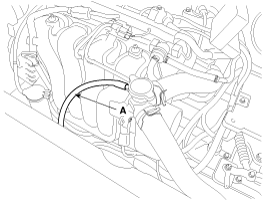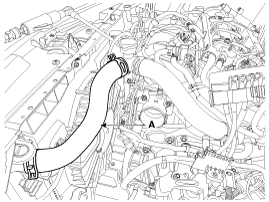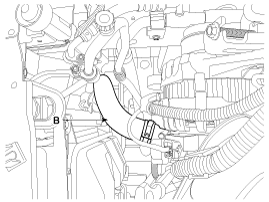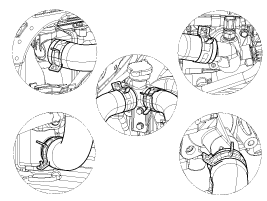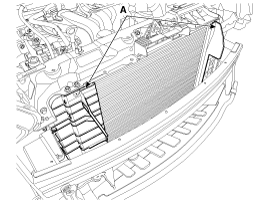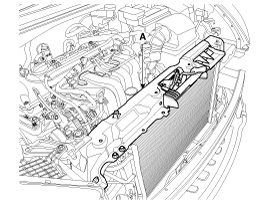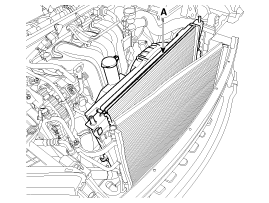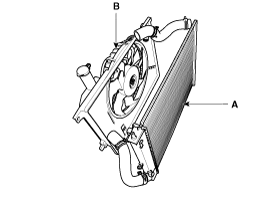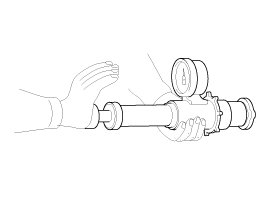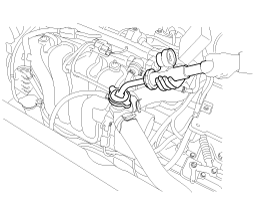Kia Cee'd: Cooling System / Radiator Repair procedures
| Removal and Installation |
| 1. |
Disconnect the battery negative terminal.
|
| 2. |
Remove the air cleaner assembly.
(Refer to Intake and exhaust system - "Air Cleaner")
|
| 3. |
Remove the battery tray.
(Refer to Engine Electrical System - "Battery")
|
| 4. |
Disconnect the over flow hose (A) from the radiator.
|
| 5. |
Loosen the drain plug, and drain the engine coolant. Remove the radiator
cap to drain with speed.
|
| 6. |
Disconnect the radiator upper hose (A) and lower hose (B).
|
| 7. |
Disconnect the ATF cooler hoses.
|
| 8. |
Remove the front bumper.
(Refer to body - "Front Bumper Cover")
|
| 9. |
Remove the air guard (A).
|
| 10. |
Remove the upper mounting bracket (A).
|
| 11. |
Separate the condenser from the radiator and then pull the radiator
(A) upper from vehicle.
|
| 12. |
Remove the cooling fan & reservior tank (A) from the radiator (B).
|
| 13. |
Install in the reverse order of removal.
|
| 14. |
Fill the radiator with coolant and check for leaks.
|
| 15. |
Put the radiator cap on tightly, then run engine again and check for
leaks.
|
| Inspection |
| 1. |
Remove the radiator cap, wet its seal with engine coolant, and then
install it on a pressure tester.
|
| 2. |
Apply a pressure of 93.16 ~ 122.58kpa (0.95 ~ 1.25kg/cm², 13.51 ~ 17.78psi).
|
| 3. |
Check for a drop in pressure.
|
| 4. |
If the pressure drops, replace the cap.
|
| 1. |
Wait until engine is cool, then carefully remove the radiator cap and
fill the radiator with engine coolant, then install a pressure tester
on it.
|
| 2. |
Apply a pressure of 93 ~ 123kPa (0.95 ~ 1.25kgf/cm², 14 ~ 19psi).
|
| 3. |
Inspect for engine coolant leaks and a drop in pressure.
|
| 4. |
If the pressure drops, check hoses, the radiator and the water pump
for leakage. If there is no leakage, inspect the heater core, the cylinder
block and the cylinder head.
|
| 5. |
Remove the tester and reinstall the radiator cap.
|
 Radiator Components and components location
Radiator Components and components location
Components
1. Radiator
2. Mounting insulator
3. Radiator upper mounting bracket
4. Radiator upper hose
5. Radiator lower hose
6. Filler neck a ...
 Cooling Fan Components and components location
Cooling Fan Components and components location
Components
1. Cooling fan
2. Fan motor
3. Fan shroud
...
Other information:
Kia Cee'd JD Owners Manual: If you do decide to pull a trailer
Here are some important points if you decide to pull a trailer:
Consider using a sway control.You can ask a hitch dealer about sway
control.
Do not do any towing with your car during its first 2,000 km (1,200
miles) in order to allow the engine to properly break in. Failure
to heed th ...
Ford Escape 2020-2025 Owners Manual: How Does Speed Sign Recognition Work. Speed Sign Recognition Precautions. Speed Sign Recognition Limitations
How Does Speed Sign Recognition Work
Speed sign recognition uses a sensor
behind the interior mirror to detect speed
signs.
If your vehicle has speed sign recognition
with navigation, stored speed sign data
may influence the indicated speed limit
value.
Speed Sign Recognition Precautions
WARNIN ...

